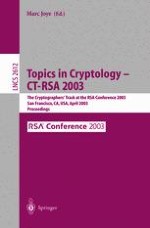2003 | Book
Topics in Cryptology — CT-RSA 2003
The Cryptographers’ Track at the RSA Conference 2003 San Francisco, CA, USA, April 13–17, 2003 Proceedings
Editor: Marc Joye
Publisher: Springer Berlin Heidelberg
Book Series : Lecture Notes in Computer Science
Included in: Professional Book Archive

